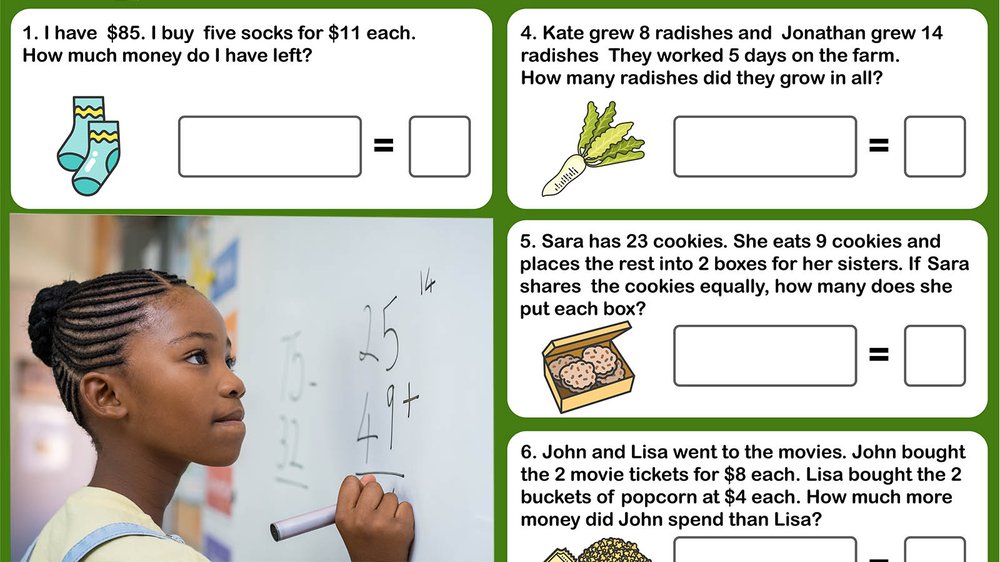A fifth-grade teacher tells her class that a person mowed their entire lawn. She gives them the length and width of the hypothetical backyard and asks them what the area of the space is. More than 90 percent of the class is unable to answer or gets the problem incorrect. The teacher knows her students understand how to calculate area and is miffed by the lack of correct answers.
What’s the disconnect? Her students, who are English Learners (ELs), did not understand the words mowed and lawn. When going over the problem later with the class, one student asks, “Why couldn’t you just say cut the grass?” They simply couldn’t make sense of the problem.
This real-life classroom example demonstrates the importance of language in teaching mathematics in today’s classrooms, especially for ELs.
The Importance of Language and Language Routines
In large part, math teachers are not trained to be language teachers. However, in classrooms with ELs, they are tasked with both teaching math content and helping students make sense of the language used in mathematics problems.
This is why language and the use of language routines are so important in helping students make meaningful connections in mathematics. Without language routines and mathematical discourse in place, it makes it hard for students to make those connections, as exemplified by the lawn mowing problem. Remember, just because students may still be learning English certainly does not mean they don’t know math.
Strategic language routines help all students boost their comprehension and learn the specialized academic language used in mathematics. One of the routines that’s most beneficial, especially for ELs, is Three Reads. Teachers can use this routine to guide students through negotiating the language in a given problem by reading the problem three times—each time with a specific focus—to ensure students understand what’s being asked of them.
In the first read, the focus is on comprehending the text. Teachers read the problem aloud while students focus on what the problem is about and prepare to respond to it. In the second read, a student reads the problem aloud while their peers focus on discerning what question is being asked. Students focus on connecting the language to the mathematics as they describe what the problem is specifically asking. In the final read, the focus is on analyzing the important information given in the problem. The problem is read chorally or by one student to another as they listen and think about the important quantities and relationships in the problem.
This routine helps students reason through language, clarify vocabulary, and interpret information presented in a problem before completing the actual mathematics. It and other research-based routines—such as co-crafting questions and problems, comparing and connecting, saying it another way, and others—can go a long way in helping students access and express their growing mathematical understanding.
Supporting Mathematical Discourse
As noted, mathematical discourse is another great way to support ELs in today’s math classrooms. In Teaching Mathematics to English Language Learners, co-author Dr. Gladis Kersaint, Dean of the Neag School of Education at the University of Connecticut and Curriculum Associates author, shares seven valuable strategies teachers can use to establish classroom environments that support mathematical discourse for all students.
These best-practice strategies include:
- Help students work with and rely on one another. Encourage students to seek assistance from peers before defaulting to the teachers and provide opportunities for students to talk about the math before whole class instruction.
- Allow students to work independently before sharing in small or large groups. Students need time to gather their thoughts and identify what they know or do not know before they are exposed to the influence of other students. Then they can compare and contrast their approaches and solutions with those shared by others during the mathematics discussion.
- Use questions and prompts. Encourage students to listen to each other and ask students to clarify or restate peers’ comments. Teach students to respectfully critique the reasoning of their peers and disagree amicably and give them some examples of how this is done. Teachers can also use sentence frames and questions to help students present their ideas.
- Use questions strategically to engage students in mathematical discourse. Engage students in mathematical discourse by posing questions that encourage discussion and debate and that explain and justify their thinking.
- Acknowledge the importance of mistakes in learning and understanding. Recognize that students will make errors because they are explaining and making conjunctures. Remind students constantly that errors are expected and natural and that they can be a good thing because they lead to enhanced learning.
- Use collaborative learning strategies to support students in preparation for whole class discussions. When students work with peers or in small groups, they are able to take risks and build confidence on a small scale before they present solutions to the whole class.
- Use a variety of pedagogical strategies to engage all students in whole class, teacher-led mathematics discussion. This is essential in engaging all students in conversation.
These collective routines and strategies can have a big impact on ELs. When coupled with using an asset-based mathematics philosophy—an approach in which a student’s background knowledge, experiences, and insights are viewed as strengths and leveraged to engage them in learning and enrich their classroom’s community—teachers can create a supportive, learning-focused classroom for all students.
About the author
Claudia Salinas is the Vice President of English Learning at Curriculum Associates and the Regional Manager for Arizona, Nevada, New Mexico, and Texas. She is responsible for helping school leaders meet the needs of their English and struggling learners by bringing research-based professional development, assessments, and standards-based instructional materials into school districts. Claudia also works with authors and editors to develop solutions to address the needs of all struggling students
Download Curriculum Associates’ Orchestrating Mathematical Discourse with English Learners rubric.
This article was adapted from “Making It Add Up for All” in Language Magazine.











